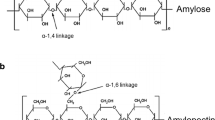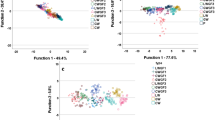Abstract
The effect of the flower and pine honey on the rheological behavior of kefir was investigated. Major aim was to produce a new functional fermented milk beverages with honey. Soluble solid was changed from 6.37 to 25.28; refractive index values were between 1.342 and 1.374; pH was changed from 4.04 to 4.65 and color values, L of samples were determined as 63.10–73.18. The rheological properties of the samples were determined using a controlled stress rheometer. It was observed that an empirical power-law model was suitable to describe the rheological behavior of kefir with honey with correlation coefficients (R 2) between 0.991 and 0.96. The apparent viscosity of the kefir with honey decreased with increasing shear rate. Flow behavior index (n) and consistency index (K) values for the kefir with honey ranged from 0.3711 to 0.4691, 130 to 204 mPa s, respectively. The model kefir with honey was found to exhibit non-Newtonian behavior.



Similar content being viewed by others
References
Ahmed J, Prabhu ST, Raghavan GSV, Ngadi M (2007) Physico-chemical, rheological, calorimetric and dielectric behavior of selected Indian honey. J Food Eng 79:1207–1213
Assil HI, Sterling R, Sporns P (1991) Crystal control in processed liquid honey. J Food Sci 56:1034–1041
Bensmira M, Nsabimana C, Jiang J (2010) Effects of fermentation conditions and homogenization pressure on the rheological properties of kefir. LWT Food Sci Technol 43:1180–1184
Butlert F, McNulty P (1995) Time dependent rheological characterisation of buttermilk at 5 °C. Food Eng 25:569–580
Duboc P, Mollet B (2001) Applications of exopolysaccharides in the dairy industry. Int Dairy J 11:759–768
Guzel-Seydim ZBG, Seydim AC, Greene AK, Bodine AB (2000a) Determination of organic acids and volatile flavor substances in kefir during fermentation. J Food Compost Anal 13:35–43
Guzel-Seydim ZG, Seydim AC, Greene AK (2000b) Organic acids and volatile flavor components evolved during refrigerated storage of kefir. J Dairy Sci 83:275–277
Guzel-Seydim Z, Wyffels JT, Seydim AC, Greene AK (2005) Turkish kefir and kefir grains: microbial enumeration and electron microscopic observation. Int J Dairy Technol 58:25–29
IDF (1997) Dairy starter cultures of lactic acid bacteria (LAB)—standard of identity, standard 149A. International Dairy Federation, Brussels
Juszczak L, Fortuna T (2006) Rheology of selected Polish honeys. J Food Eng 75:43–49
Kavas A (1990) Saglıklı beslenmede kuru ve incir ve cekirdeksiz kuru uzumun onemi semineri. Tebligi 4:53–65
Kayacier A, Dogan M (2006) Rheological properties of some gums-salep mixed solution. J Food Eng 72:261–265
Koksoy A, Kilic M (2003) Effects of water and salt level on rheological properties of ayran, a Turkish yoghurt drink. Int Dairy J 13:835–839
Koksoy A, Kilic M (2004) Use of hydrocolloids in textural stabilization of a yoghurt drink, ayran. Food Hydrocoll 18:593–600
Kristensen D, Jensen PY, Madsen F, Birdi KS (1997) Rheology and surface tension of selected processed dairy fluids: influence of temperature. J Dairy Sci 80:2282–2290
Lazaridou A, Biliaderis CG, Bacandritsos N (2004) Composition, thermal and rheological behaviour of selected Greek honeys. J Food Eng 64:9–21
Lucey JA, Tamehana M, Singh H, Munro PA (1999) Stability of model acid milk beverage: effect of pectin concentration, storage temperature and milk heat treatment. J Texture Stud 30:305–318
Mossel B, Bhandari B, Bruce DA, Caffin N (2000) Use of an Arrhenius Model to predict rheological behaviour in some Australian honeys. Lebensm Wiss Technol 33:545–552
Ouchemoukh S, Louaileche H, Schweitzer P (2006) Physicochemical characteristics and pollen spectrum of some Algerian honeys. Food Control 18:52–58
Paraskevopoulou A, Athanasiadis I, Blekas G, Koutinas AA, Kanellaki M, Kiosseoglou V (2003) Influence of polysaccharide addition on stability of a cheese whey kefir-milk mixture. Food Hydrocoll 17:615–620
Penna ALB, Sivieri K, Oliviera MN (2001) Relation between quality and rheological properties of lactic beverages. J Food Eng 49:7–13
Pintado ME, da Silva JAL, Fernandes PB, Malcata X, Hogg TA (1996) Microbiological and rheological studies on Portuguese kefir grains. Int J Food Sci Technol 31:15–26
Rimada PS, Abraham AG (2006) Kefiran improves rheological properties of glucono-skim milk gels. Int Dairy J 16:33–39
SAS (1998) SAS/STAT user’s guide (6.03). SAS Institute Inc, Cary
Tamine AY, Marshall VME (1997) Microbiology and technology of fermented milks. In: Law BA (ed) Microbiology and biochemistry of cheese and fermented milk. Blackie Academic & Professional, London, 152 pp
Torre L, Tamine Y, Muir DD (2003) Rheology and sensory profiling of set-type fermented milks made with different commercial probiotic and yoghurt starter cultures. Int J Dairy Technol 56:163–170
Tratnik L, Bozanic R, Herceg Z, Drgalic I (2006) The quality of plain and supplemented kefir from goat’s and cow’s milk. Int J Dairy Technol 59:40–46
Witthun RC, Schoeman T, Britz TJ (2004) Isolation and characterization of the microbial population of different South African kefir grains. Int J Dairy Technol 57:33–37
Wszolek M, Tamine AY, Muir DD, Barclay MNI (2001) Properties of kefir made in Scotland and Poland using bovine, caprine and ovine milk with different starter cultures. Lebensm Wiss Technol 34:251–261
Acknowledgments
This work has been financed by Erciyes University Scientific Research Center and Turkish Ministry of Development (DPT).
Author information
Authors and Affiliations
Corresponding author
Rights and permissions
About this article
Cite this article
Doğan, M. Rheological behaviour and physicochemical properties of kefir with honey. J. Verbr. Lebensm. 6, 327–332 (2011). https://doi.org/10.1007/s00003-010-0643-6
Received:
Accepted:
Published:
Issue Date:
DOI: https://doi.org/10.1007/s00003-010-0643-6




